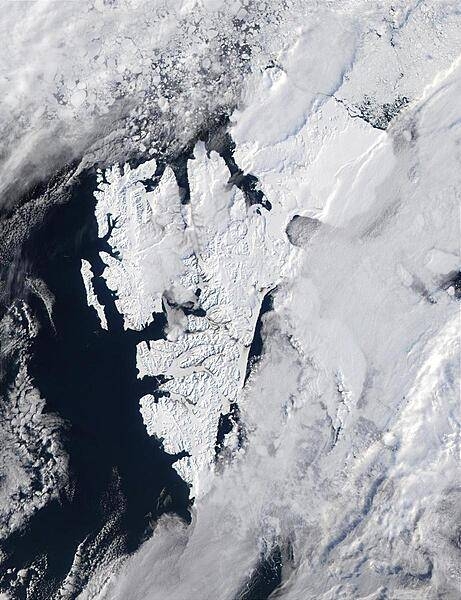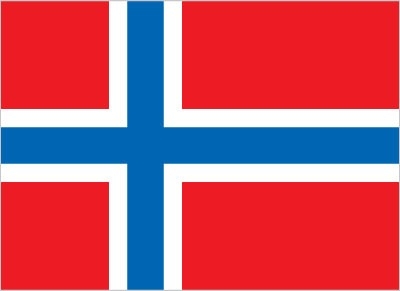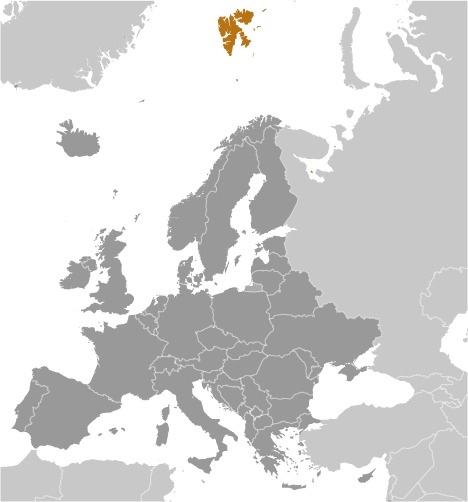Svalbard
Introduction
Background
The archipelago may have been first discovered by Norse explorers in the 12th century; the islands served as an international whaling base during the 17th and 18th centuries. Norway's sovereignty was internationally recognized by treaty in 1920, and five years later it officially took over the territory. In the 20th century coal mining started and today a Norwegian and a Russian company are still functioning. Travel between the settlements is accomplished with snowmobiles, aircraft, and boats.
Visit the Definitions and Notes page to view a description of each topic.
Geography
Location
Northern Europe, islands between the Arctic Ocean, Barents Sea, Greenland Sea, and Norwegian Sea, north of Norway
Geographic coordinates
78 00 N, 20 00 E
Map references
Arctic Region
Area
total: 62,045 sq km
land: 62,045 sq km
water: 0 sq km
note: includes Spitsbergen and Bjornoya (Bear Island)
Area - comparative
slightly smaller than West Virginia
Land boundaries
total: 0 km
Coastline
3,587 km
Maritime claims
territorial sea: 12 nm
contiguous zone: 24 nm
continental shelf: extends to depth of exploitation
exclusive fishing zone: 200 nm
Climate
arctic, tempered by warm North Atlantic Current; cool summers, cold winters; North Atlantic Current flows along west and north coasts of Spitsbergen, keeping water open and navigable most of the year
Terrain
rugged mountains; much of the upland areas are ice covered; west coast clear of ice about half the year; fjords along west and north coasts
Elevation
highest point: Newtontoppen 1,717 m
lowest point: Arctic Ocean 0 m
Natural resources
coal, iron ore, copper, zinc, phosphate, wildlife, fish
Land use
agricultural land: 0% (2018 est.)
other: 100% (2018 est.)
Population distribution
the small population is primarily concentrated on the island of Spitsbergen in a handful of settlements on the south side of the Isfjorden, with Longyearbyen being the largest
Natural hazards
ice floes often block the entrance to Bellsund (a transit point for coal export) on the west coast and occasionally make parts of the northeastern coast inaccessible to maritime traffic
Geography - note
northernmost part of the Kingdom of Norway; consists of nine main islands; glaciers and snowfields cover 60% of the total area; Spitsbergen Island is the site of the Svalbard Global Seed Vault, a seed repository established by the Global Crop Diversity Trust and the Norwegian Government
People and Society
Ethnic groups
Norwegian 61.1%, foreign population 38.9% (consists primarily of Russians, Thais, Swedes, Filipinos, and Ukrainians) (2021 est.)
note: foreigners account for almost one third of the population of the Norwegian settlements, Longyearbyen and Ny-Alesund (where the majority of Svalbard's resident population lives), as of mid-2021
Languages
Norwegian, Russian
major-language sample(s):
Verdens Faktabok, den essensielle kilden for grunnleggende informasjon. (Norwegian)
The World Factbook, the indispensable source for basic information.
Age structure
0-14 years: NA
15-24 years: NA
25-54 years: NA
55-64 years: NA
65 years and over: NA
Dependency ratios
total dependency ratio: NA
youth dependency ratio: NA
elderly dependency ratio: NA
potential support ratio: NA
Death rate
NA (2021 est.)
Population distribution
the small population is primarily concentrated on the island of Spitsbergen in a handful of settlements on the south side of the Isfjorden, with Longyearbyen being the largest
Infant mortality rate
total: NA
male: NA
female: NA (2021 est.)
Life expectancy at birth
total population: NA
male: NA
female: NA (2021 est.)
Total fertility rate
NA (2021 est.)
Drinking water source
improved: urban: NA
rural: NA
total: NA
unimproved: urban: NA
rural: NA
total: NA
Environment
Environment - current issues
ice floes are a maritime hazard; past exploitation of mammal species (whale, seal, walrus, and polar bear) severely depleted the populations, but a gradual recovery seems to be occurring
Climate
arctic, tempered by warm North Atlantic Current; cool summers, cold winters; North Atlantic Current flows along west and north coasts of Spitsbergen, keeping water open and navigable most of the year
Land use
agricultural land: 0% (2018 est.)
other: 100% (2018 est.)
Government
Country name
conventional long form: none
conventional short form: Svalbard (sometimes referred to as Spitsbergen, the largest island in the archipelago)
etymology: 12th century Norse accounts speak of the discovery of a "Svalbard" - literally "cold shores" - but they may have referred to Jan Mayen Island or eastern Greenland; the archipelago was traditionally known as Spitsbergen, but Norway renamed it Svalbard in the 1920s when it assumed sovereignty of the islands
Government type
non-self-governing territory of Norway
Dependency status
territory of Norway; administered by the Polar Department of the Ministry of Justice, through a governor (sysselmann) residing in Longyearbyen, Spitsbergen; by treaty (9 February 1920), sovereignty was awarded to Norway
Capital
name: Longyearbyen
geographic coordinates: 78 13 N, 15 38 E
time difference: UTC+1 (6 hours ahead of Washington, DC, during Standard Time)
daylight saving time: +1hr, begins last Sunday in March; ends last Sunday in October
etymology: the name in Norwegian means Longyear Town; the site was established by and named after John LONGYEAR, whose Arctic Coal Company began mining operations there in 1906
Independence
none (territory of Norway)
Legal system
the laws of Norway where applicable apply; only the laws of Norway made explicitly applicable to Svalbard have effect there; the Svalbard Act and the Svalbard Environmental Protection Act, and certain regulations, apply only to Svalbard; the Spitsbergen Treaty and the Svalbard Treaty grant certain rights to citizens and corporations of signatory nations; as of June 2017, 45 nations had ratified the Svalbard Treaty
Citizenship
see Norway
Executive branch
chief of state: King HARALD V of Norway (since 17 January 1991); Heir Apparent Crown Prince Haakon MAGNUS (son of the king, born 20 July 1973)
head of government: Governor Lars FAUSE (since 24 June 2021); Vice Governor Solvi ELVEDAHL (since 1 May 2020)
elections/appointments: none; the monarchy is hereditary; governor and assistant governor responsible to the Polar Department of the Ministry of Justice
Legislative branch
description: unicameral Longyearbyen Community Council (15 seats; members directly elected by majority vote to serve 4-year-terms); note - the Council acts very much like a Norwegian municipality, responsible for infrastructure and utilities, including power, land-use and community planning, education, and child welfare; however, healthcare services are provided by the state
elections: last held on 7 October 2019 (next to be held in October 2023)
election results: seats by party - Conservatives 5, Labor Party 5, Liberals 3, Green Party 2
Judicial branch
highest courts: none; note - Svalbard is subordinate to Norway's Nord-Troms District Court and Halogaland Court of Appeal, both located in Tromso
Political parties and leaders
Svalbard Conservative Party [Kjetil FIGENSCHOU]
Svalbard Green Party [Pal BERG]
Svalbard Labor Party [Arild OLSEN]
Svalbard Liberal Party [Terie AUVENIK]
Svalbard Progress Party [Jorn DYBDAHL]
Flag description
the flag of Norway is used
National anthem
note: as a territory of Norway, "Ja, vi elsker dette landet" is official (see Norway)
Economy
Economic overview
Coal mining, tourism, and international research are Svalbard's major industries. Coal mining has historically been the dominant economic activity, and the Spitzbergen Treaty of 9 February 1920 gives the 45 countries that so far have ratified the treaty equal rights to exploit mineral deposits, subject to Norwegian regulation. Although US, UK, Dutch, and Swedish coal companies have mined in the past, the only companies still engaging in this are Norwegian and Russian. Low coal prices have forced the Norwegian coal company, Store Norske Spitsbergen Kulkompani, to close one of its two mines and to considerably reduce the activity of the other. Since the 1990s, the tourism and hospitality industry has grown rapidly, and Svalbard now receives 60,000 visitors annually.
The settlements on Svalbard were established as company towns, and at their height in the 1950s, the Norwegian state-owned coal company supported nearly 1,000 jobs. Today, only about 300 people work in the mining industry.
Goods such as alcohol, tobacco, and vehicles, normally highly taxed on mainland Norway, are considerably cheaper in Svalbard in an effort by the Norwegian Government to entice more people to live on the Arctic archipelago. By law, Norway collects only enough taxes to pay for the needs of the local government; none of tax proceeds go to the central government.
Budget
revenues: NA
expenditures: NA
Exports
NA
Imports
$NA
Exchange rates
Norwegian kroner (NOK) per US dollar -
8.308 (2017 est.)
8.0646 (2016 est.)
8.0646 (2015)
8.0646 (2014 est.)
6.3021 (2013 est.)
Energy
Refined petroleum products - consumption
80,250 bbl/day (2013 est.)
country comparison to the world: 87Communications
Telecommunication systems
general assessment: modern, well-developed (2018)
domestic: the Svalbard Satellite Station - connected to the mainland via the Svalbard Undersea Cable System - is the only Arctic ground station that can see low-altitude, polar-orbiting satellites; it provides ground services to more satellites than any other facility in the world (2018)
international: country code - 47-790; the Svalbard Undersea Cable System is a twin communications cable that connects Svalbard to mainland Norway; the system is the sole telecommunications link to the archipelago (2019)
note: the COVID-19 pandemic continues to have a significant impact on production and supply chains globally; since 2020, some aspects of the telecom sector have experienced downturn, particularly in mobile device production; many network operators delayed upgrades to infrastructure; progress towards 5G implementation was postponed or slowed in some countries; consumer spending on telecom services and devices was affected by large-scale job losses and the consequent restriction on disposable incomes; the crucial nature of telecom services as a tool for work and school from home became evident, and received some support from governments
Broadcast media
the Norwegian Broadcasting Corporation (NRK) began direct TV transmission to Svalbard via satellite in 1984; Longyearbyen households have access to 3 NRK radio and 2 TV stations
Internet users
total: 1,542 includes usage for Jan Mayen (2021 est.)
country comparison to the world: 230Transportation
Airports - with paved runways
total: 1
2,438 to 3,047 m: 1 (2019)
Airports - with unpaved runways
total: 3
under 914 m: 3 (2013)
Heliports
1 (2013)
Ports and terminals
major seaport(s): Barentsburg, Longyearbyen, Ny-Alesund, Pyramiden
Military and Security
Military and security forces
no regular military forces
Military - note
Svalbard is a territory of Norway, demilitarized by treaty on 9 February 1920; Norwegian military activity is limited to fisheries surveillance by the Norwegian Coast Guard (2021)
Transnational Issues
Disputes - international
despite recent discussions, Russia and Norway dispute their maritime limits in the Barents Sea and Russia's fishing rights beyond Svalbard's territorial limits within the Svalbard Treaty zone



